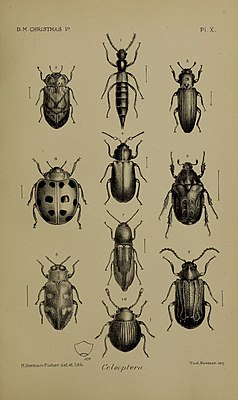Henosepilachna nativitatis
| Henosepilachna nativitatis | ||||||||||||
|---|---|---|---|---|---|---|---|---|---|---|---|---|

Illustration from Henosepilachna nativitatis , second row, first figure |
||||||||||||
| Systematics | ||||||||||||
|
||||||||||||
| Scientific name | ||||||||||||
| Henosepilachna nativitatis | ||||||||||||
| ( Arrow , 1900) |
Henosepilachna nativitatis (English common name : Christmas Island ladybird ) is a poorly understood Marienkäferart that on to Australia belonging Christmas Island in the Indian Ocean endemic is. It is known only from a few specimens collected in the late 19th century by Joseph Jackson Lister , Charles William Andrews and the crew of the HMS Flying Fish . Nothing is known about its habitat and way of life.
features
The characteristics and dimensions refer to two specimens (a male and a female) that are kept in the Natural History Museum in London . The body lengths are 7.3 and 7.5 mm. The body is oval and somewhat flattened. The pronotum , the label and the base color of the elytra are pale dirty brownish yellow. The points on the head are densely arranged and of moderate size. The areas between the points are smooth and shiny. The points of the pronotum are slightly smaller than those on the head. The wing covers each have six black spots. All spots are rounded, only the third spot is somewhat transverse and larger than the other spots. The puncturing of the wing covers consists of two points. The rough points are shallow and six to seven times larger than the small ones, which in turn are smaller than the points on the head and on the pronotum. The coarse points are arranged irregularly, the small ones regularly. The hair on the elytra is short and close-fitting. The hair is gold in color, the hair on the spots is black. The shoulder bumps are large and clearly visible. The end of the elytra is rounded. The underside of the body is brownish yellow with a slightly darker metasternum .
Systematics
Henosepilachna nativitatis was described in 1900 by Gilbert John Arrow as Epilachna nativitatis . Gerhard Heinrich Dieke classified the taxon in 1947 as a subspecies of Epilachna boisduvali (today Henosepilachna boisduvali ). Ryszard Bielawski explained in 1961 that there are morphological differences, especially with regard to the male genitalia, between the two taxa and considered Epilachna nativitatis again as an independent species. In 2003 the genus Epilachna was revised and the species was placed in the genus Henosepilachna .
Hazard and protection
Henosepilachna nativitatis is currently not recorded by the IUCN . This ladybird has not been detected since its early collections in the 19th century and has been considered lost ever since.
literature
- Ryszard Bielawski: About Epilachna nativitatis Arrow, 1900, from Christmas Island in the Indian Ocean (Coleoptera, Coccinellidae). Bulletin de l'Academie Polonaise des Sciences, Warszawa, Série des sciences biologiques, Cl. II - Vol. IX, No. 9, Varsovie, 1961, pp. 387-390
Individual evidence
- ↑ Charles Owen Waterhouse, Charles Joseph Gahan, Gilbert John Arrow: Order 4 - Coleoptera In: Charles W. Andrews: A Monograph of Christmas Island (Indian Ocean), Physical Features and Geology , 1900, pp. 95-96
- ↑ Gerhard Heinrich Dieke: Lady Beetles of the genus Epilachna (Sens Lat..) In Asia, Europe, and Australia Thomas Lincoln Casey Fund. Smithsonian Miscellaneous Collections, Volume 106, Number 15. Publication 3860, 1947, p. 80
- ^ Ryszard Bielawski: About Epilachna nativitatis Arrow, 1900, from the Christmas Island in the Indian Ocean (Coleoptera, Coccinellidae). Bulletin de l'Academie Polonaise des Sciences, Warszawa, Série des sciences biologiques, Cl. II - Vol. IX, No. 9, Varsovie, 1961, pp. 387-390
- ^ Andrzej S. Jadwiszczak, Piotr Węgrzynowicz: World Catalog of Coccinellidae: Part I - Epilachninae , Mantis, Olsztyn, 2003, p. 161
- ^ John Woinarski: The Fate of Christmas Island Nature In: A Bat's End: The Christmas Island Pipistrelle and Modern Extinction in Australia Csiro Publishing, 2018, ISBN 978-1-486-30863-7 , p. 91